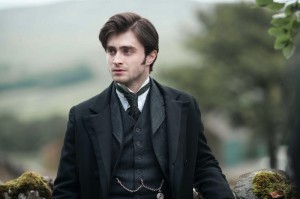You have no items in your cart. Want to get some nice things?
Go shopping
While many horror writers imagine ghosts along distinctly sympathetic Freudian lines—there’s something in their past that’s making them behave in such wicked ways, and if they can just work through their issues with the help of a willing human being everything will be all right again—Susan Hill isn’t having any of it.
There’s something refreshingly awful about Susan Hill’s ghosts. She brings random nastiness back to the ghost story; the haunting is just bad luck in a chaotic universe, something like cancer or a lightning strike. If it hits you, your luck’s run out, and no amount of begging or bribery is going to make it any better. Hill’s ghosts are masterpieces of blind hatred. They’re angry, they want revenge and if they happen to notice you, poor innocent mortal, you can try to run and you can try to hide but it doesn’t matter, because they’re coming to get you.
For me, that’s the secret to the continuing power The Woman in Black has as a story. It horrifies people. First published in 1983, it now appears on school curriculums, has been adapted for the stage (extremely successfully—the West End production is enjoying its thirteenth year), and has now been made into a film starring Daniel Radcliffe.
The Woman in Black tells the tragic story of lawyer Arthur Kipps, widower and sole provider for an adorable four year old son. Kipps is sent into the country to put Eel Marsh House, the estate of a recently dead client, in order. But when he arrives at the village of Crithin Gifford, he begins to notice strange goings-on. The village’s children keep dying under mysterious circumstances; the villagers themselves seem strangely unhappy with the idea of Arthur visiting Eel Marsh House; and Arthur sees a veiled woman in a black dress, watching him…
Like most ghost stories, when you see it on screen its premise begins to seem slightly awkward. You’re left with logical questions, such as why anyone who believes, as the villagers do, that a malign presence is after their children wouldn’t just take the kids and run. Or why Kipps remains so obtuse for so long—a woman clad in black screaming into my face as I look out the window? Must be a trick of the mind! It’s important to remember, though, that people in horror films have an additional instinct-response to frightening situations: fight, flight, and wander around in vague circles while the doom closes in. I’ll admit that, quibbles aside (and largely due to the excellence of its source material), The Woman in Black creates a much neater supernatural universe than most of its competition. Of course, as a Hammer Horror film, it has a noble pedigree; the studio’s been in the business long enough to know exactly when to subtly fray your nerves, when to ramp up the tension, and when to give you a face-full of nastiness.
The film’s best feature is its visuals. There are some absolutely brilliant horror moments: a child’s little boot crunches down onto a doll’s head, and there’s a reflection in the mirror that only the audience can see. Hill’s also excellent at creating atmosphere—the lurking dread in each fog bank and deserted roadway—and that’s something this film has managed to capture very well. Eel Marsh House is surrounded by a beautifully bare landscape, and the house itself is satisfyingly weed-tangled and twisty. Everything, in short, looks right.
Content-wise though, the film is slightly more problematic. Once Kipps arrives at Eel Marsh House for his night of terror, I sometimes began to feel as if I were watching someone play a solve-the-puzzle computer game. You hear a noise. Go to the noise. You find CLOCKWORK ANIMAL! Pick up the animal. You find HIDDEN LETTERS! You read LETTERS. You hear a noise. Go to the noise. You find ROCKING CHAIR! Touch ROCKING CHAIR. WOMAN IN BLACK jumps out at you! Game over.
Kipps himself also causes some issues. I do slightly question the casting of Daniel Radcliffe. Yes, there’s the looming spectre of Harry Potter (“He should just say Expecto Patronum!” said my boyfriend, as the Woman closed in), but what was far more distracting to me was his age. Radcliffe does actually do a fairly good job as Kipps, but he’s so distractingly young that his acting abilities almost don’t matter. He’s closer in age and appearance to the film’s doomed children than he is to the rest of its its large, middle-aged grown-ups, and the question of how he could respectably manage to have a part in the creation of a four-year-old child distracted me for quite some time.
That said, Hammer are playing this one old-fashioned, trying to give everything the feel of a classic bone-chiller, and the result is a fairly respectable adaptation of Hill’s book for the big screen. With one major exception.
If you have read the book, you know what happens anyway, and if you haven’t I can’t spoil it for you if I just say: they changed the ending. Unfortunately, that one change manages to negate the entire tone and concept of the preceding film. It’s as nonsensical as changing an Agatha Christie plot, like taking a table and sawing off one of its legs off to make it more streamlined. Sure, the result is lighter, but it’s also no longer any use as a table. I understand why they did it, but it infuriates me, and it leaves the film much weaker than it would otherwise be.
The Woman In Black film is definitely not bad, grading to good at times. But all the same, if you want real horror, there’s just no substitute for the original. If you want to experience Kipps’s story the way it should be told, go and read the book. Be careful, though. Once you finish it you may not sleep for a week.

About Robin Stevens
Robin started out writing literary features for Litro and joined the team in November 2012. She is from Oxford by way of California, and she recently completed an English Literature MA at King's College, London. Her dissertation was on crime fiction, so she can now officially refer to herself as an expert in murder (she's not sure whether she should be proud of that). Robin reviews books for The Bookbag and on her own personal blog, redbreastedbird.blogspot.co.uk. She also writes children's novels. Luckily, she believes that you can never have too many books in your life.




